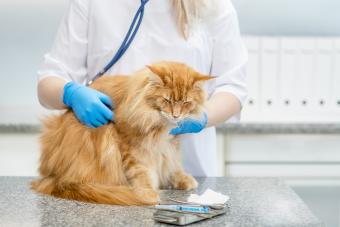
It's important to be alert for the signs of rabies in cats, especially if your kitty has recently been bitten by a wild animal or an unknown cat or dog. Rabies is a deadly virus spread via the saliva when an infected animal bites. Knowing its stages and signs can help you keep from putting your family at risk.
Stages of Feline Rabies
According to the Centers for Disease Control (CDC), cats are the most reported domestic animal to be diagnosed with rabies. Each stage of rabies in cats has certain behaviors and symptoms associated with it. Knowing the classic symptoms of each stage will help you recognize the disease. If you suspect your pet may have rabies, take it to your vet immediately.
VCA Hospitals notes there are three stages of rabies, which can be identified by their symptoms.
Prodromal Phase
The first stage of rabies is called the Prodromal phase, which lasts for one to three days. The Merck Veterinary Manual states symptoms may be hard to identify at first, but generally take less than 21 days to 80 days to set in, with symptoms worsening quickly. The first symptoms may include:
- Fever spikes
- Erratic behavior
- Temperament changes
- Excessive drooling
- Pupil dilation
- Seeking solitude
- Loss of appetite
- Biting objects
- Scratching at the site of the bite
Remember, temperament changes can be subtle. An aloof and independent cat may suddenly jump into your lap and want to be pet. A cat that has previously been loving may growl and run away from their owner.
Furious Phase

The second stage of rabies is called the Furious phase. This stage usually begins on the second or third day. It is during this stage the cat will display increasingly erratic behavior. For example, they may begin to eat inedible objects like stones or sticks. Other behaviors you might see in this stage of rabies include:
- Wandering around
- Hypersensitivity to environmental stimuli
- Aggressive or violent behavior
- Irritability
- Biting themselves
- Fly biting (snapping at objects that are not there)
- Disorientation
- Seizures
- Growling
- Trembling
- Lack of muscle coordination
Paralytic Phase
The third stage of rabies is the Paralytic stage, also referred to as the Dumb phase. The cat will become depressed and unresponsive. Other symptoms include:
- "Foaming" at the mouth
- Weakness
- Labored breathing
- Choking
- Respiratory failure
- Coma
- Paralysis that eventually leads to death
Rabies Vaccine
Rabies can be controlled. If your cat receives a rabies vaccine on a regular schedule, they will be protected against rabies. The vaccine is usually given when your cat is about 3 to 4 months old depending on the laws in place in your area of residence with a booster shot one year afterward. After that, vaccines be administered every one to three years.
How often your cat receives the shot depends on the type of vaccine used and state regulations, so check with your vet to make sure your cat is up to date. Even if your pet is vaccinated for rabies, however, they should be seen by a vet immediately if you suspect they have been exposed. They will have a 10-day period of quarantined observation and they may get a possible booster vaccine to make sure they haven't been infected.
How Do You Know if Your Cat Has Rabies?
It is essential you watch for the above signs of rabies. There is no cure for rabies once it has set in. Fewer than twenty people have ever survived after exposure without getting the rabies vaccine before symptoms set in. If your pet seems to have any symptoms of rabies, it is important to be cautious in your interactions with them. A cat in the first phase of the disease can turn from docile to dangerous quickly, and one bite from an infected animal is all it takes to infect you. If you suspect your cat may have been bitten by a rabid animal, contact a veterinarian as soon as possible to begin the quarantine process.







